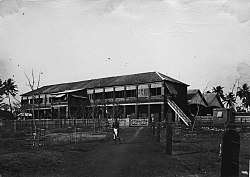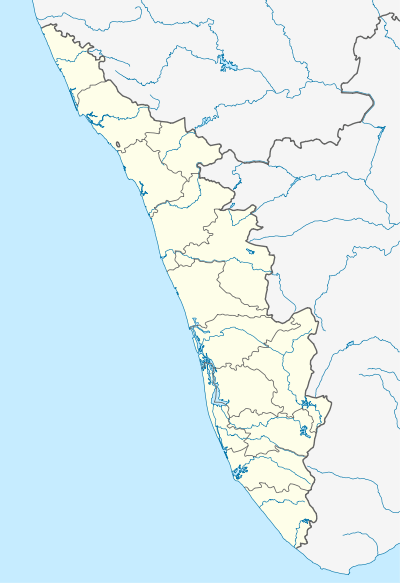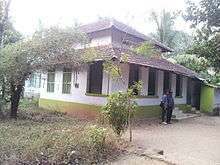Chaliyam
| Chaliyam | |
|---|---|
|
Town Village | |
 Beypore Railway Station, incorrectly named, at Chaliyam was the terminus of the Madras Railway (South-West Line). | |
 Chaliyam Location in Kerala, India | |
| Coordinates: 11°09′21″N 75°48′30″E / 11.15592°N 75.80824°ECoordinates: 11°09′21″N 75°48′30″E / 11.15592°N 75.80824°E | |
| Country | India |
| State | Kerala |
| District | Kozhikode |
| STD Code | 0495 |
| Postal Code | 673301 |
Chaliyam (Malayalam: ചാലിയം) is a village situated at the estuary of Chaliyar (River Beypore) in Kozhikode, Kerala. Chaliyam forms an island, bounded by the Chaliyar in the north, and River Katalundi in south, and the Conolly Canal in the east. Chaliyam (Beypore Railway Station) was the former terminus of the South-West Line of the Madras Railway.
Different names of Chaliyam:
- Muslim Navigators: al-Shaliat [1] Chaliyam, at small port south of Kozhikode at the time, is not regularly mentioned under this name in the Arabic and Persian geographical literature. It does feature in Abu al-Fida's Taqwin al-Buldan (14th century). Two fourteenth century Islamic tombstones are recorded at the site.[2]
- European Navigators: Chale/Challe/Chalia or Chaly[3]
- Saliyam: the home of the Saliya community. The Saliyas figure as the dominant weaving community in medieval South India. Presently, the Chaliya (Chaliyan or Saliya) is an Other Backward Class in Kerala.[4]
Chaliyam is believed to be one of the location of the founding mosques of Kerala. As per this tradition, the qazi of the mosque established at Chaliyam was Taqy ud-Din.[5] Ibn Batutah seems to have visited Chaliyam in 14th century AD. He describes the settlement: "I next came to the city of Shaliat, where the Shaliats are made and hence they derive their name. This is a fine city..."[6]
Some sources allude to the presence Jewish settlements (12th and 13th centuries AD) in Chaliyam.[7]
As per a peace agreement between Portuguese Viceroy Nunho de Acunha and the Samutiri of Kozhikode, a Portuguese fort was constructed at Chaliyam in 1531 AD. The Fort Chaliyam was eventually besieged, captured and destroyed by the Kozhikode forces in 1571. A certain Portuguese officer called Attaide was in charge of the fort at this time.[8][9]
Chaliyam is also famous for the Khalasi.[10]
Beypore Railway Station, incorrectly named, at Chaliyam was the terminus of the Madras Railway (South-West Line).[11]
Important Landmarks
- Lighthouse, Chaliyam
- Umbhichi Hajee Higher Secondary School Chaliyam
- NIRDHESH Project
- Itti Achuthan Memorial Hortus Malaricus Plants Museum
- Noorudheen Shaikh Jaram (Darga)
- Seawalk (0ne km)
- Puzhakkara Srambia with ancient shadow-clock.
- Engattil Mazjid (Old Srambia)
- Vadakkumbad Kamaliyya School (100 year old)
- Jankar service across Chaliyar River to Beypore port
- Relics of the old Chaliyam fort
- Chaliyam Coastal Police Station
Suburbs and Villages near Chaliyam
- Vallikkunnu, Anangadi and Anappady
- Kacherikunnu, Athanikkal and Anayarangadi
- Kottakkadavu, Pediyattukunnu and Edachira
- Kadalundi, Vattaparambu and Pazhanjannor
- Kadukkabazar and Chaliyarkadavu
See also
Image Gallery
References
- ↑ Henry Yule. Cathay and the Way Thither, Being a Collection of Medieval Notices of China, Volume 1 Taylor & Francis, 2017
- ↑ Hall. Secondary Cities & Urban Networking in the Indian Ocean Realm, c. 1400-1800 Lexington Books, 1955
- ↑ Henry Yule. Cathay and the Way Thither, Being a Collection of Medieval Notices of China, Volume 1 Taylor & Francis, 2017
- ↑ Kerala Public Service Commission
- ↑ William Logan. Malabar: District Manual, Volume 1 Asian Educational Services, 1887
- ↑ William Logan. Malabar: District Manual, Volume 1 Asian Educational Services, 1887
- ↑ Jewish Virtual Library
- ↑ K. M. Panikkar. A History of Kerala 1498-1801. pp. 102
- ↑ William Logan. Malabar: District Manual, Volume 1 Asian Educational Services, 1887
- ↑ K. M. Panikkar. A History of Kerala 1498-1801. pp. 102
- ↑ William Logan. Malabar: District Manual, Volume 1 Asian Educational Services, 1887
| Wikimedia Commons has media related to Chaliyam. |






